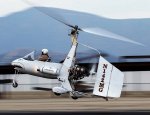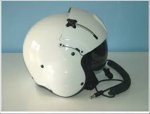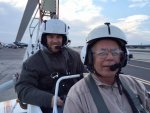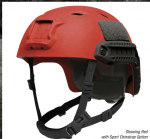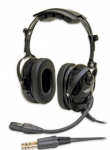The first two items on my pre-takeoff list are: seat belt fastened? Helmet secure?
I won't start the engine until I get an affirmative from the passenger and I have visually checked the helmet strap.
A passenger briefing is required by FAR 91.519.
Sec. 91.519 — Passenger briefing.
(a) Before each takeoff the pilot in command of an airplane carrying passengers shall ensure that all passengers have been orally briefed on—
(1) Smoking. Each passenger shall be briefed on when, where, and under what conditions smoking is prohibited. This briefing shall include a statement, as appropriate, that the Federal Aviation Regulations require passenger compliance with lighted passenger information signs and no smoking placards, prohibit smoking in lavatories, and require compliance with crewmember instructions with regard to these items;
(2) Use of safety belts and shoulder harnesses. Each passenger shall be briefed on when, where, and under what conditions it is necessary to have his or her safety belt and, if installed, his or her shoulder harness fastened about him or her. This briefing shall include a statement, as appropriate, that Federal Aviation Regulations require passenger compliance with the lighted passenger sign and/or crewmember instructions with regard to these items;
(3) Location and means for opening the passenger entry door and emergency exits;
(4) Location of survival equipment;
(5) Ditching procedures and the use of flotation equipment required under §91.509 for a flight over water; and
(6) The normal and emergency use of oxygen equipment installed on the airplane.
(b) The oral briefing required by paragraph (a) of this section shall be given by the pilot in command or a member of the crew, but need not be given when the pilot in command determines that the passengers are familiar with the contents of the briefing. It may be supplemented by printed cards for the use of each passenger containing—
(1) A diagram of, and methods of operating, the emergency exits; and
(2) Other instructions necessary for use of emergency equipment.
(c) Each card used under paragraph (b) must be carried in convenient locations on the airplane for the use of each passenger and must contain information that is pertinent only to the type and model airplane on which it is used.
(d) For operations under subpart K of this part, the passenger briefing requirements of §91.1035 apply, instead of the requirements of paragraphs (a) through (c) of this section.
You are also required to explain the experimental nature of the aircraft and what the means.
91.319 d
(d) Each person operating an aircraft that has an experimental certificate shall -
(1) Advise each person carried of the experimental nature of the aircraft;
(2) Operate under VFR, day only, unless otherwise specifically authorized by the Administrator; and
(3) Notify the control tower of the experimental nature of the aircraft when operating the aircraft into or out of airports with operating control towers.
Not doing this could possibly fail your check ride.

